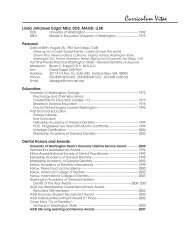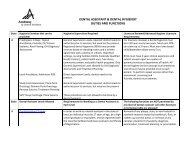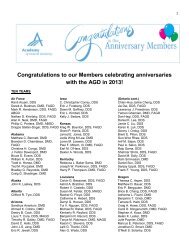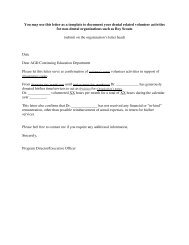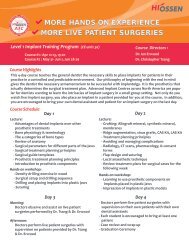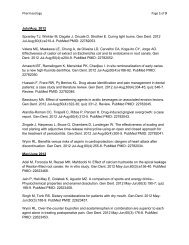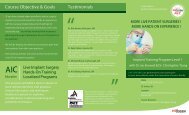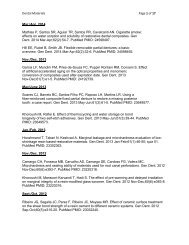dental assistant & dental hygienist duties and functions - Academy of ...
dental assistant & dental hygienist duties and functions - Academy of ...
dental assistant & dental hygienist duties and functions - Academy of ...
Create successful ePaper yourself
Turn your PDF publications into a flip-book with our unique Google optimized e-Paper software.
DENTAL ASSISTANT & DENTAL HYGIENIST<br />
DUTIES AND FUNCTIONS<br />
State<br />
MN<br />
Hygienist Services that can be<br />
provided:<br />
Local Anesthesia; S<strong>of</strong>t Tissue<br />
Curettage; Administer N20; Study Cast<br />
Impressions; Place Perio Dressings;<br />
Remove Perio Dressings; Remove<br />
Sutures<br />
Prophylaxis; X‐Rays; Pit/ Fissure<br />
Sealants; Fluoride; Root Planing<br />
Topical Anesthesia<br />
Hygienist Supervision Required:<br />
General Supervision Levels required; dentist needs to<br />
authorize prior to services, but need not be present.<br />
General Supervision Levels required; dentist needs to<br />
authorize prior to services, but need not be present.<br />
A <strong>dental</strong> <strong>hygienist</strong> may be employed or retained by a<br />
health care facility, program, or nonpr<strong>of</strong>it<br />
organization to perform <strong>dental</strong> hygiene services<br />
without the patient first being examined by a licensed<br />
dentist if the <strong>dental</strong> <strong>hygienist</strong> has entered into a<br />
collaborative agreement with a licensed dentist that<br />
designates authorization for the services provided by<br />
the <strong>dental</strong> <strong>hygienist</strong>.<br />
Licensure Renewal/Advanced Hygiene Licensure<br />
Requirements:<br />
For licensure renewal, a <strong>dental</strong> <strong>hygienist</strong> must<br />
earn 25 hours every two years <strong>and</strong> be current in<br />
CPR. Minimum 15 hrs in “core” courses required.<br />
Must complete two <strong>of</strong> the following categories per<br />
cycle—infection control; record keeping; ethics;<br />
patient communications; management medical<br />
emergencies; <strong>and</strong> treatment <strong>and</strong> diagnosis. Must<br />
maintain a “portfolio” to record documentation <strong>of</strong><br />
fundamental <strong>and</strong> elective pr<strong>of</strong>essional<br />
development activities, CPR certification, <strong>and</strong> a<br />
biennial self-assessments (on a board approved<br />
form)<br />
Dental <strong>hygienist</strong>s in health care settings must have<br />
been engaged in the active practice <strong>of</strong> clinical<br />
<strong>dental</strong> hygiene for not less than 2,400 hours in the<br />
past 18 months or a career total <strong>of</strong> 3,000 hours,<br />
Place Sutures; DH Diagnosis/<br />
These procedures are not allowed to be done by a<br />
including a minimum <strong>of</strong> 200 hours <strong>of</strong> clinical<br />
Assessment; Treatment Planning <strong>dental</strong> <strong>hygienist</strong>.<br />
practice in two <strong>of</strong> the past three years. Has<br />
documented participation in courses in infection<br />
control <strong>and</strong> medical emergencies within each<br />
continuing education cycle <strong>and</strong> maintains current<br />
certification in advanced or basic<br />
cardiac life support as recognized by the American<br />
Heart Association, the American Red Cross, or<br />
another agency that is equivalent to the American<br />
Heart Association or the American Red Cross.<br />
State Dental Assistant Levels Allowed Requirements for Working as a Dental Assistant at The following <strong>functions</strong> are NOT permitted by
Each Level<br />
MN Dental Assistant A <strong>dental</strong> <strong>assistant</strong> in the state <strong>of</strong> Minnesota may perform<br />
basic supportive <strong>dental</strong> procedures specified by the state<br />
<strong>dental</strong> practice act (see opposite page) under the<br />
supervision <strong>of</strong> a licensed dentist. There are no education or<br />
training requirements for this level <strong>of</strong> <strong>dental</strong> assisting.<br />
Registered Dental Assistant (RDA) To earn status as a Registered Dental Assistant<br />
(RDA), <strong>dental</strong> <strong>assistant</strong>s in the state <strong>of</strong> Minnesota<br />
must:<br />
•Graduate from a CODA- accredited <strong>dental</strong><br />
assisting program<br />
OR<br />
•Pass the national DANB Certified Dental Assistant<br />
(CDA) exam<br />
AND<br />
•Complete a Board-approved course in exp<strong>and</strong>ed<br />
<strong>functions</strong> in Minnesota<br />
AND<br />
•Pass the Minnesota Registration exam within five<br />
years prior to application for registration<br />
AND<br />
•Pass the Minnesota Jurisprudence Exam<br />
AND<br />
•Apply for registration to the Minnesota Board <strong>of</strong><br />
Dentistry<br />
Note: All regulated <strong>dental</strong> <strong>assistant</strong>s must be current<br />
in Cardiopulmonary Resuscitation (CPR) at the Health<br />
Care Provider level.<br />
any level <strong>of</strong> <strong>dental</strong> <strong>assistant</strong> (all other <strong>functions</strong><br />
in list below table are allowed)<br />
Scaling <strong>of</strong> teeth; diagnosis, including interpretation <strong>of</strong><br />
<strong>dental</strong> radiographs <strong>and</strong> treatment planning; cutting <strong>of</strong><br />
tooth structure; surgical procedures on hard <strong>and</strong> s<strong>of</strong>t<br />
tissues including, but not limited to, the removal <strong>of</strong><br />
teeth <strong>and</strong> the cutting <strong>and</strong> suturing <strong>of</strong> s<strong>of</strong>t tissues;<br />
prescription, injection, <strong>and</strong> parenteral administration <strong>of</strong><br />
drugs; final bending <strong>of</strong> archwire prior to ligations;<br />
administration <strong>of</strong> general anesthesia or conscious<br />
sedation<br />
Registered Dental Assistant qualified<br />
in exp<strong>and</strong>ed <strong>functions</strong><br />
To perform exp<strong>and</strong>ed <strong>functions</strong> under the<br />
supervision <strong>of</strong> a licensed dentist in the state <strong>of</strong><br />
Minnesota, Registered Dental Assistants must<br />
complete a CODA-accredited course in each <strong>of</strong> the<br />
exp<strong>and</strong>ed <strong>functions</strong> listed on the opposite page.
Dental Assisting Functions List<br />
The following is a list <strong>of</strong> 70 <strong>dental</strong> assisting tasks developed by the ADAA/DANB Alliance in the course <strong>of</strong> its research. These selected<br />
tasks were determined to be representative <strong>of</strong> a broad range <strong>of</strong> <strong>dental</strong> assisting core competencies.<br />
Functions in each state that correspond to the national Core Competency Study <strong>functions</strong> are numbered in the Career Ladder Template, using<br />
language directly from the state’s <strong>dental</strong> practice act. Functions listed with bullets in the Career Ladder Template are part <strong>of</strong> the state’s practice<br />
act but are not specific matches to DANB research.<br />
1. Perform mouth mirror inspection <strong>of</strong> the oral cavity<br />
2. Chart existing restorations or conditions<br />
3. Phone in prescriptions at the direction <strong>of</strong> the dentist<br />
4. Receive <strong>and</strong> prepare patients for treatment, including seating, positioning chair, <strong>and</strong> placing napkin<br />
5. Complete laboratory authorization forms<br />
6. Place <strong>and</strong> remove retraction cord<br />
7. Perform routine maintenance <strong>of</strong> <strong>dental</strong> equipment<br />
8. Monitor <strong>and</strong> respond to post- surgical bleeding<br />
9. Perform coronal polishing procedures<br />
10. Apply effective communication techniques with a variety <strong>of</strong> patients<br />
11. Transfer <strong>dental</strong> instruments<br />
12. Place amalgam for condensation by the dentist<br />
13. Remove sutures<br />
14. Dry canals<br />
15. Tie in archwires<br />
16. Demonstrate knowledge <strong>of</strong> ethics/ jurisprudence/patient confidentiality<br />
17. Identify features <strong>of</strong> rotary instruments<br />
18. Apply topical fluoride<br />
19. Select <strong>and</strong> manipulate gypsums <strong>and</strong> waxes<br />
20. Perform supragingival scaling<br />
21. Mix <strong>dental</strong> materials<br />
22. Expose radiographs<br />
23. Evaluate radiographs for diagnostic quality<br />
24. Provide patient preventive education <strong>and</strong> oral hygiene instruction<br />
25. Perform sterilization <strong>and</strong> disinfection procedures<br />
26. Provide pre- <strong>and</strong> post-operative instructions<br />
27. Place <strong>and</strong> remove <strong>dental</strong> dam<br />
28. Pour, trim, <strong>and</strong> evaluate the quality <strong>of</strong> diagnostic casts<br />
29. Size <strong>and</strong> place orthodontic b<strong>and</strong>s <strong>and</strong> brackets
30. Using the concepts <strong>of</strong> four- h<strong>and</strong>ed dentistry, assist with basic restorative procedures, including prosthodontics <strong>and</strong> restorative dentistry<br />
31. Identify intraoral anatomy<br />
32. Demonstrate underst<strong>and</strong>ing <strong>of</strong> the OSHA Hazard Communication St<strong>and</strong>ard<br />
33. Place, cure <strong>and</strong> finish composite resin restorations<br />
34. Place liners <strong>and</strong> bases<br />
35. Place periodontal dressings<br />
36. Demonstrate underst<strong>and</strong>ing <strong>of</strong> the OSHA Bloodborne Pathogens St<strong>and</strong>ard<br />
37. Take <strong>and</strong> record vital signs<br />
38. Monitor vital signs<br />
39. Clean <strong>and</strong> polish removable appliances <strong>and</strong> prostheses<br />
40. Apply pit <strong>and</strong> fissure sealants<br />
41. Prepare procedural trays/ armamentaria set-ups<br />
42. Place orthodontic separators<br />
43. Size <strong>and</strong> fit stainless steel crowns<br />
44. Take preliminary impressions<br />
45. Place <strong>and</strong> remove matrix b<strong>and</strong>s<br />
46. Take final impressions<br />
47. Fabricate <strong>and</strong> place temporary crowns<br />
48. Maintain field <strong>of</strong> operation during <strong>dental</strong> procedures through the use <strong>of</strong> retraction, suction, irrigation, drying, placing <strong>and</strong> removing cotton rolls, etc.<br />
49. Perform vitality tests<br />
50. Place temporary fillings<br />
51. Carve amalgams<br />
52. Process <strong>dental</strong> radiographs<br />
53. Mount <strong>and</strong> label <strong>dental</strong> radiographs<br />
54. Remove temporary crowns <strong>and</strong> cements<br />
55. Remove temporary fillings<br />
56. Apply topical anesthetic to the injection site<br />
57. Demonstrate underst<strong>and</strong>ing <strong>of</strong> the Centers for Disease Control <strong>and</strong> Prevention Guidelines<br />
58. Using the concepts <strong>of</strong> four- h<strong>and</strong>ed dentistry, assist with basic intraoral surgical procedures, including extractions, periodontics, endodontics, <strong>and</strong> implants<br />
59. Monitor nitrous oxide/oxygen analgesia<br />
60. Maintain emergency kit<br />
61. Remove permanent cement from supragingival surfaces<br />
62. Remove periodontal dressings<br />
63. Place post-extraction dressings<br />
64. Fabricate custom trays, to include impression <strong>and</strong> bleaching trays, <strong>and</strong> athletic mouthguards<br />
65. Recognize basic medical emergencies<br />
66. Recognize basic <strong>dental</strong> emergencies<br />
67. Respond to basic medical emergencies
68. Respond to basic <strong>dental</strong> emergencies<br />
69. Remove post-extraction dressings<br />
70. Place stainless steel crown<br />
List <strong>of</strong> <strong>dental</strong> <strong>assistant</strong> <strong>duties</strong> developed by the American Dental Assistant Association/Dental Assisting National Board (ADAA/DANB) Alliance. Dental <strong>assistant</strong>s<br />
are allowed to perform these tasks, unless indicated that they are NOT allowed to permit certain <strong>functions</strong> outlined in the chart.<br />
Much information for <strong>dental</strong> <strong>assistant</strong> <strong>duties</strong> was obtained from DANB (www.danb.org); other information was taken from state <strong>dental</strong> board web sites.<br />
Information about services that can be provided by <strong>dental</strong> <strong>hygienist</strong>s, as well as the different levels <strong>of</strong> service was compiled using three separate documents from the American<br />
Dental Hygienist Association:<br />
http://www.adha.org/governmental_affairs/downloads/direct_access.pdf<br />
http://www.adha.org/governmental_affairs/downloads/fiftyone.pdf<br />
http://www.adha.org/governmental_affairs/downloads/CE.pdf<br />
This information is provided for informational purposes only; it is not intended as a legal opinion regarding <strong>dental</strong> assistance requirements in any state



